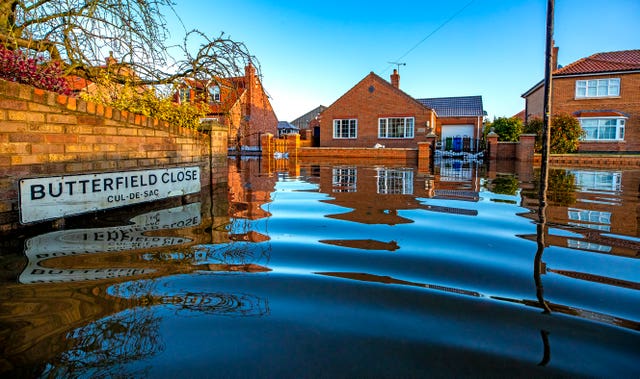
The owner of a bunglalow left almost completely submerged by flooding has said his focus is on preventing the same thing happening to other families in the future.
Kevin Lorryman’s home is just one of dozens in the East Yorkshire communities of Snaith and East Cowick which were inundated a week ago when the River Aire spilled out of its normal washlands, creating a vast inland sea.
Mr Lorryman’s Snaith bungalow has become a symbol of the recent flooding which has affected many areas of England and Wales, with just its roof and its solar panels visible above the muddy, 9ft (3m) deep floodwater.
Despite facing the prospect of his home having to be completely demolished, the 56-year-old said he is keen to make sure no-one forgets the scores of other families in East Yorkshire and beyond in a similar situation.

He said: “I just want people to think about all the other people around here who have been affected.
“There are hundreds. I think it’s 69 houses in total affected in East Cowick, not far away, as well as those in Snaith.
“They are all in the same situation I am in. Even those who’ve just had a few inches, it’s caused a huge amount of damage and it will take a lot of recovery.”
Mr Lorryman is now living in his caravan as prepares to move into a rented house while the home he lived in with his daughter, son-in-law and two grandchildren slowly re-emerges from the receding water.
He said the local community has pulled together in response to the crisis but he wants to see the country more prepared for these situations in the future.
“Going forward, there needs to be action taken at a much higher level to prevent this happening again,” he said.

“East Riding Council teams have come in and everyone here has been brilliant but it needs to be sorted at a much higher level – emergency response teams put in place to respond to these things.
“And we need to build flood resilience in.
“I don’t want my family to go through this again. I don’t want anyone to go through this again.”
Mr Lorryman said he is hoping to use his insurance money to build another home on slightly higher ground on his land.
He said his neighbours had been inundated with donations of clothes and other items but still needed help and urged people to donate to a Just Giving page set up by the community.
More than 150 residents attended a meeting at Snaith Primary School on Monday night where they questioned officials from a range of organisations, including East Riding of Yorkshire Council and the Environment Agency.
The council said at the height of the floods that 23 homes had been flooded in Snaith, with 65 affected in nearby East Cowick. On Tuesday it said the combined total was now 93.
It said water levels had dropped around 12 inches (30cm) overnight from Monday to Tuesday as vast amounts of water were being pumped to the River Don and after the Aire, Don and Ouse Consortium of Internal Drainage Boards dug a series of trenches that have helped reduce flood water levels.

Brigette Giles, head of technology and transformation and emergency control centre manager at East Riding of Yorkshire Council, said: “The council and its partners have been working around the clock since the flooding incident started a week ago and will continue to provide a high level of support over the coming days and weeks for those affected as we move into recovery.”
Paul Abbott, head of housing, transportation and public protection and the council’s lead for recovery operations, said: “The council is aware of 93 properties that have flooded in Snaith and East Cowick and our officers will be going door-to-door to provide any and all advice and support and to arrange any assistance that might be needed to help our residents and businesses.”
The clear-up operation in the lower Aire catchment is just one of scores going on around northern England, the Midlands and Wales as the UK continues to experience one of its wettest, and warmest, winters on record.
Across December, January and February, the country was deluged with an average total of 469.7mm of rain, according to Met Office figures released this week.
Last month has already been confirmed as the wettest February on record, with an average of 209.1mm measured across the UK.


Comments: Our rules
We want our comments to be a lively and valuable part of our community - a place where readers can debate and engage with the most important local issues. The ability to comment on our stories is a privilege, not a right, however, and that privilege may be withdrawn if it is abused or misused.
Please report any comments that break our rules.
Read the rules here